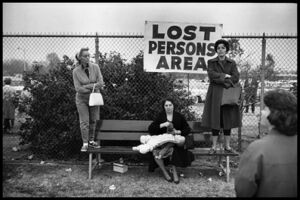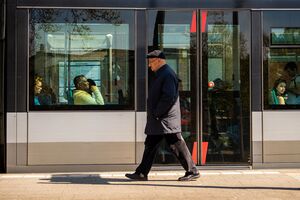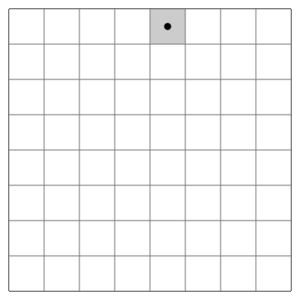Garvan's Text on Practice 2022
recent work
My recent video 'The Misadventures of Gravy the Clown' (2022 - 3:59min) is a video work that follows a young man's journey into the world of a clown, performed entirely by me.The misadventures of this clown illustrate a relationship between comedy and tragedy. The tragedy of the work is that the young man cannot escape pain, and he is heartbroken after his beloved unicycle goes missing This work is performative, absurd, melodramatic and kitsch. I had been interested in the figure of a clown for quite some time and this work was a much needed exploration of my curiosity of performance. The performance is contained within the video but there was also a performance in the making of the video and I pushed myself to perform the shots in public wearing clown paint. I used the costume of a clown to make clear to the audience, and to make clear to myself, that I am the clown. The makeup is a bridge that allows me to be vulnerable and aids in my ability to perform. In one sense, it is not strange for someone in clown makeup to act the fool. There are contemporary clown from Mr.Bean to Boris Johnson. Though their makeup and strategies can vary greatly. I have become greatly interested in the online personas and videos of Youtube creators. I often watch and greedily indulge in videos by photography youtubers. I was interested in critiquing this discourse as it is often an echo chamber and very much fetishises the superficial and material aspects of photography. I wanted to satirise this by creating my own youtube persona, akin to Gravy the Clown in that this character would be foolish, naive and slightly tragic. I made two Youtube Vlogs as a performance prototype to test the waters and also as a challenge to familiarise myself further with performing in front of a camera and choreographing my body.
Street photography
Currently I am building a large body of street photography work This is how I have been developing my photographic skills and training my eye. I have been documenting the weekly Binnenrotte and Afrikaanderplein markets . The dense crowds and sensory bombardment make it a good place to photograph passing strangers. People of many walks of life are found here.
I have taken to photograph the streets, almost as an act of surrendering myself to unpredictability. I could design photos on paper, I could write narratives that I want to photograph but this is already all happening on the street. I am attracted to the notion of honesty. As if by capturing sincere moments of a city in motion, I am making work that is human. This process is highly active. I hold my camera in my hands, raising it and lowering it from my eye, scanning for a scenario or a figure of interest to enter the frame. I am looking for interactions, transactions, oddities, expressions. I I think of it like fishing in a vast sea or lake. There are countless photographs swimming below the surface. I could stick my hand blindly into the water and splash about clumsily til my fingers close around something. I could cast-off and reel in different images, some small minnows and some mackerel. Some I could let back into the water, others I could toss in my bucket. But I am learning now that perhaps the best way might be to slowly observe the waters, and drop my net and wait for something bigger, and when the weight of the rope seems heavy and full I will pull my catch from the depths. This means moving slower, standing in place, observing, and being patient. I could weave my net by defining parameters for my process. Knowing exactly what time of day I will take pictures. Perhaps selecting one lens to make the entire body of work.
This is a photo by Elliot Erwitt taken in 1963 in California. This photo poses more questions than it solves. The first thing that strikes my eye is the sign with bold text saying ‘LOST PERSONS AREA’ then I travel to the right of the sign at the woman with her arms folded standing atop the bench, she is lost, or she is searching for someone who is lost. My gaze then bounces across the frame to the other woman with her arms folded atop the bench, she is leaning forward and looking to the left of the frame. Then my eyes drop to the woman and child sitting between and beneath the two standing figures. The child is sprawled across her lap, as if unconscious. The woman has something in her hands that I cannot decipher. Finally I move lower again and I can see a fourth woman in the bottom right corner, she appears also to be searching for something. What is going on in this picture? I do not know, all these questions bombard me into bemusement but I am charmed by the chaotic harmony of the composition. To analyse this photo further I shall use two parameters; the studium and the punctum. The studium is the sum of the meaning of the picture. It is often the intended meaning or reading, it summarises the linguistic signs but it also compresses the photo into easily understandable rhetoric. The Punctum is an opposing or complimentary element that punctures through the signs and symbols of a photo, revealing a hidden layer of meaning and connection. In the above photo, I could say that its Studium is the text LOST PERSONS AREA, it describes that this is an event in the 1960s, taken candidly by Erwitt. It is documentarian, it is a snapshot, it is four women and a child in a certain time and place. The Punctum, for me, is the child. Sprawled across the sitting woman’s lap, more questions arise. Is that woman the child’s mother? Is the child lost? Has the child been found? What is the woman holding in her hands above the child? The infant is an extra layer of meaning that I cannot fully signify but it evokes from me an emotional response. Another Punctum (they are subjective) is the man in the suit standing in the distance behind the mesh wire fence. I am reminded of cold-war images of secret service men in black suits, he stands outside of the event, watching through the fence.
I took this photo in april, it is the one street photograph I have made that has these dual elements of Studium and Punctum. I made this photograph to capture the man walking away from the tram stop. With the cars of the tram creating a backdrop. The man is the studium, he is the subject man walks from the tram stop. That is an objective description and rather a lacklustre image. The punctum is the young woman to the right edge of the frame. Her shoulder and face are in sunlight and she appears to look directly at the camera. She breaks the stillness of the image and reveals the photographer (me). I then become aware of my reflection muddled in the other forms of refracted lights dancing on the tram's windows. I like this photograph but to me the duality of the studium and punctum are not as powerful or as profound as I would hope. It does not pose as many questions as Erwitt’s, the layers of meaning are thin.
Gravy the Clown and my current street photography work may seem very different or even at odds with each other. One is an absurd fictional video, the other is a growing body of still images that are documentarian in nature. In one I am in front of the camera, the other I am behind it. But these works are both by me and are made with my lens. For Gravy the Clown I story boarded, and researched and prototyped, practised and rehearsed. This is a process I do with my photographs. I take a picture, I adjust, I retake, I reframe, I compose and I expose and repeat. In-post, I crop and draw in or push away the shadows and highlights. I prototype with different lenses, I take pictures on my phone that may work better ( or worse) with my dslr. I prototype by printing and blowing things up, I review them. There is also a conversation happening in both works between me and the city. In the video work, I performed in front of the camera in a public space, acting perhaps for strangers walking by as something that I myself would like to photograph. In my photography I am navigating markets and streets with my body.In my video and photographic practice they both rely on my camera and my eye. To develop these skills I need to make more. To refine it I must set my parameters and push my composition and concepts into greater focus.
Plan & Parameters
My plan is to set certain parameters and structures to hone my craft. The Studium and Punctum as theorised by Roland Barthes can become considerations I use with my camera but will also become a tool for my self evaluation. It is a duality by which I can asses and quantify my work. Contextualising my photographs is also a path that I must explore, do my photos only exist in the saturated realm of street photography? Where can this photographic work bring me? In a greater sense, what am I trying to communicate by making these images.
Recently I am considering expanding my street photography practice in a more conceptual direction. I have research constrained methods by the Oulipo collective and I am fascinated by the mathematical puzzle The Knights Tour. This is a pattern of movement that the chess piece, the knight, can take to land on every square of the chess board exactly once. Could I translate this path onto a map of Rotterdam and only take one photo at each square/street/stall. Equally visions of a chess board arise in my minds eye that images themselves could become, I could make nine categories from Kings to Pawns. And what do these characterisations mean in a photo? What is a bishop image compared to a rook?
bibliography
J. Windsor (2021) Magnum Photos



